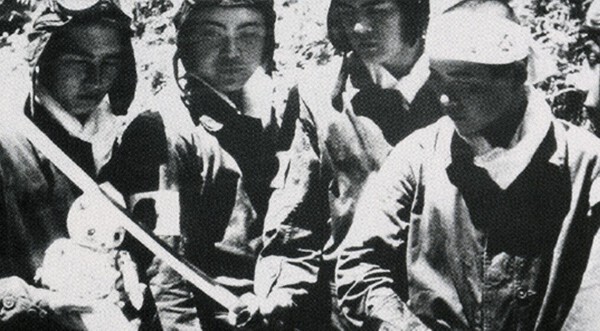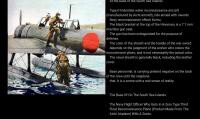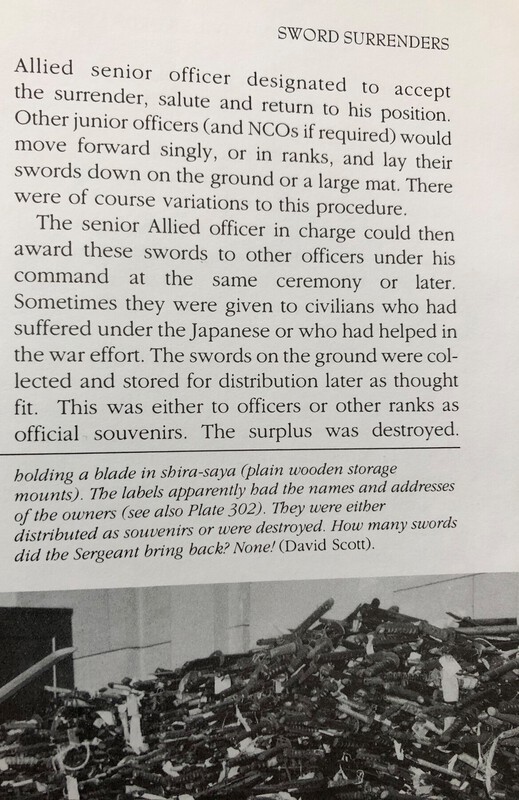-
Posts
13,111 -
Joined
-
Last visited
-
Days Won
157
Content Type
Profiles
Forums
Events
Store
Downloads
Gallery
Posts posted by Bruce Pennington
-
-
Adam,
What I can say factually: There are no known Japanese military uniform regulations that mention such a category for gunto. There are no known mil specs for the design of such a gunto. While on the other hand, we have seen the actual documents that lay out the specs for officer and NCO gunto, and NONE of them allow for waki-length gunto. We have photos of pilots carrying katana-lenght gunto, and none carrying waki-length gunto.
We know of the practice of carrying family waki into combat from as early as WWI through the end of WWII. We know of the sword shortages that prompted civilians to donate family blades, waki & katana, and the army program to buy civil swords. So there were quite a large number of waki blades re-fitted for WWII. I have read a story of a young Lt who went to a sword shop to have his long blade cut down because he was short, and he wasn't a pilot or tanker or submariner. as well as a letter written by a surviving professional polisher who stated that swords were made to match the height of the soldier.
Were there ever Japanese pilots, tankers, or submariners that carried a waki? Who knows! It is possible. We just don't have actual evidence that anyone did.
I personally believe the terms got started from early collectors right after WWII that had no idea what a wakizashi was, so they simply deducted that such a short gunto MUST have been carried be these professions.
-
 1
1
-
-
Looks circular to me. My first thought was "grinder" but the cuts are too narrow for a grinder. These have curved, perpendicular lines in them. I must say, though, I've never inspected a drilled mark in steel to see what it looks like inside!
I suppose it could be a small diameter grinder stone, like on a dremel. It would explain the irregular shapes. I would think a drill would be quite uniform in the cut.
Well, sorry for sidetracking your great thread Elielson! Enjoy your journey with this blade!
-
-
-
Mark,
Thanks, that's a nice example. I haven't tracked the serial numbers on these, but this is a fairly early one! I'll forward to Stegel and Shamsy to see what they say.
Also, one of our members has just obtained an old book on sword and fitting shops. Maybe he'll find something for us.
-
 1
1
-
-
5 hours ago, David Flynn said:
To attain a sword there was a pecking order. However, because he was so low on the Totem, he was in a raffle, but missed out
That's an interesting window into history David! Shows how desired these swords were, even back then. That they were treated so poorly, once they got back home with them, seems puzzling in light of this. I understand the front-line troop who faced the enemy in horrible combat, resenting Japanese and treating the sword with disrespect (weed whacking, etc) after the war, but even that - why bring a war trophy home at all if it isn't valued? Maybe it was taken as a prize after a battle, but when the guy gets home, and PTSD starts having it's affect, the sword becomes a trigger of his pain?
-
 2
2
-
-
9 minutes ago, mywei said:
Looks like Sako Nobumitsu
Thanks Matt! I compared it to some others posted on NMB and I see it now! Appreciate it!
-
-
HI guys!
Could I get a translation on this mei, please? It's on a kaigunto. Looks like it was re-mounted once.

-
2 hours ago, Mister Gunto said:
Interesting. I'd never seen the swords handed out formally like that before. Usually you just hear about the soliders being allowed to take one from the captured stockpile.
I wonder if they did this for the benefit of the military film crew? Or if that was something more common in the Australian Army?
Thanks for sharing this, Peter!
It was done quite a bit, by all the Allies. These are from Fuller & Gregory:
-
 4
4
-
-
26 minutes ago, Steve D said:
Roughly the centrepoint between the tip and mune(?)
You're learning fast! Ha! That notch is the mune machi (mune meaning back edge). "machi" is the notch; one on either side. "Ha-machi is on the cutting edge side.
And yes, likely torii sori. To the eye, it looks koshi sori, but that is an illusion due to the blade tip being narrow and the end near the machi being wider. But now, I'm speaking WAY out of my area of experience!
-
 1
1
-
-
Steve,
Good start on the measurements. A biggie is "sori". Check this site on how to measure it: http://japaneseswordindex.com/measure.htm
You'll eventually need to remove the habaki. Rust can make that more difficult to do. I use a hard plastic, like the edge of a spatula or something similar, against the front edges of the habaki, then tap it with a hammer. It will break the rust-lock without scratching the blade or damaging the habaki.
-
19 hours ago, Babu said:
Hi I've been offered a sword by the Smith now identified as 一刀斎安綱作 -smith Ittōsai Yasutsuna.
Adam,
Quite a beautiful blade! I have had the same translator experience on the Ohmura website, where it gives dates that are decades off. I agree this blade was likely made in 1940.
Any chance you could get the seller to give us a good clear pic of the WHOLE nakago, in case that stamp is at the end?
-
-
-
Yes, I see it now! I have seen a couple that color, but they are the exception. Ohmura shows one that color, and his site sort of specializes in showing high-class examples of gunto. Nice to see yours was actually in use, as there is tell-tale hand oils imbedded in the underside of the tsuka. Shows that the gunto didn't just sit in a dorm room corner.
-
Looks celluloid to me. but you're the one with it in hand. Tap on it. Does it ring like metal or is it flat like plastic? Either way, you've got a mighty rare dirk their buddy boy!
-
And Showa 18 means 1943. (Showa era 1926 + 18 -1 = 1943. You always subtract 1 with each of these dates).
Maybe you can give a close-up of the ito? It looks brown in the picture you posted.
Hopefully one of the guys who research smiths can give you the page you're looking for.
-
6 hours ago, PNSSHOGUN said:
It is clearly a period Seki-To......why on earth would someone go to the effort of putting in a fake Mei of a low level smith? Not to mention the presence of the Sho stamp, I can't recall seeing an unsigned/dated blade with just an acceptance stamp before.
Which is why I feel like this is original, but with a rookie doing the mei cutting. With sword shortages, possibly they just pushed it through. The blade was good, screwed up writing would be covered by the tsuka - let it pass!
-
Fuller mentions the late war use of celluloid for same'. He even said the crossguard and pommel could be made of celluloid gilded, even a celluloid scabbard! (pages 147-148 of his 1996 edition). The only metal (is yours metal, or could it be gilded celluloid?) saya he shows is a custom dirk of unknown purpose, likely a gift or presentation. But, it isn't official navy style - no sakura or leaves. By the looks of yours, I wouldn't be surprised to find out the saya is celluloid too!
In any case, it's the only one I've ever seen like it!
-
 1
1
-
-
Never! Is that saya all metal?
Is it Trystan that has the massive dirk collection, or is it you? Someone around here is quite experienced with dirks.
-
7 hours ago, IJASWORDS said:
The Kanji on the suspicious sword are stamped in with tool like a screwdriver point, not cut or chiseled as is normally done.
Yes, fat and course.
-
1 hour ago, george trotter said:
Have fun.
Welcome back George! Good to see you!
-
Matt,
I assume there's no date on the other side of the nakago (tang)? If not, the Showa stamp puts your blade in the 1935-1942 range with the greater odds at 1940 as a manufacture date.
That's quite a unique style of writing the "hiro"! He was adding a little artistic flair on that one!






















Novice looking for advice
in Military Swords of Japan
Posted
Matthew,
That's a good lookin' Mantetsu. Please do me a favor and get the seller to send you a pic of the full serial number on the nakago mune (back edge of tang). Quite often have to remove the habaki to reveal the full number.
If you buy it, please post more pics of the whole rig. Love to see it all. Also, at least PM me with your purchase price. I'm very curious to see what the COVID market price is on Mantetsu these days.